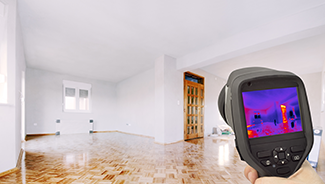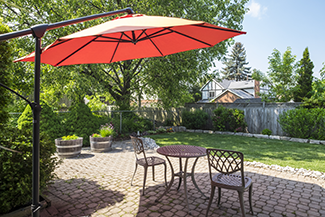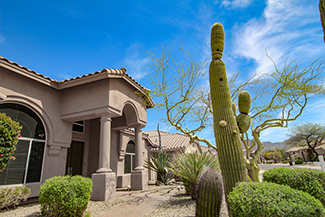“Keep Your Cool!” Shade, Sunscreens, Supercooling, and More!
 16 June 2020
16 June 2020 

"How can I keep my home cool, and do it affordably?"
Rosie understands why one of the most common questions this time of year is, "how can I keep my home cool, and do it affordably?"
It is obvious when talking to Rosie that he is passionate about helping people achieve their goal of keeping their home comfortable in the summer.
Rosie says, "keeping your home cool while living on the desert floor, in the southwest, in the summer heat, can be especially challenging when daytime highs are in the 100 and teens, and the nighttime lows are 90 degrees or above. The main issue is that, with such extreme heat, the home and its surfaces do not have a chance to shed their heat gain before the sun rises again."

To find out where your home is gaining the most heat, invest in an infrared laser thermometer and take a reading of the temps of various exterior surfaces of your home. You might be really surprised at the amount of heat your home is gaining and how hard your home is working. Other places where you can test for loss of cooling are inside of the house at your windows and around electrical sockets.
Shade
Rosie recommends that before you spend money on anything in an effort to save money on your electric bill, stop to consider ways you can shade your home. Shade can lower the temperature of the surfaces and the ambient temperature of the air by 15 or 20 degrees.
Here are some examples of the difference shade can make from a recent day at Rosie's house when the temp was 110:
- A west facing wall in full exposure to the sun: 150 degrees
- That same wall with the same orientation but under the shade of a patio: 104 degrees
- The concrete tile floor of a west facing patio: 123 degrees
- The same concrete tile floor behind a pulldown shade screen: 96 degrees
- The tiff lawn in the back yard: 100 degrees
- The same lawn under the shade of Oleanders: 88 degrees

Creating shade can be as simple as strategically planting a tree on the south or west side of the home to reduce the amount of energy it takes to cool your house down. Rosie recommends, "homeowners should consider the mature size of the tree you choose before planting. Plant far enough from the home that the roots won't interfere with the foundation. Also, branches overhanging the roof can cause damage to the roof as well as provide a highway for critters to get on the house and into the attic."
Note: Shade sails have become very popular. Rosie cautions that they are not a DIY project and should be designed by a licensed structural engineer. If they are bolted to a fascia, they can rip the entire fascia off the house in the event of high winds. If poles are used to support a sail, they require massive footings to keep them from being pulled out of the ground in high winds.
Sunscreens
Rosie believes sunscreens provide one of the highest returns on investment. SRP agrees stating:
"About 50% of the heat that enters your home comes through the windows. This makes shade screens one of the most effective and affordable energy-efficiency upgrades. While blocking heat gain, shade screens can protect your home's interior from sun damage, provide added privacy, and cut cooling costs."

Rosie adds, "to be the most effective, screens should be large enough to cover the glass and the frame. The perfect screen is installed ½ inch away from the window, allowing hot air to escape. You do not want the heat transfer that occurs when screens touch the glass."
Roll down shades at the edge of a patio or black out shades installed inside on each window also work well to help keep the heat out. Taking measures to shade and screen your home will be very beneficial while you are supercooling.
Whole Home Energy Audit
"One of the biggest mistakes homeowners make is to make random purchases as they hear about products that claim to cut heat gain and save on energy. It is usually the case that random purchasing will give random results", says Rosie. The first thing to do is to have a whole house energy audit, also known as a home performance energy audit. It will give you concrete information about where you ought to focus and where you ought to focus first. A whole house energy audit, performed by a Rosie Certified Contractor, will give you a detailed report of your home's energy performance. Search the category "Energy Efficiency" for your closest certified partner!
Energy Management
Time-of-day energy consumption is the best way to save dollars on your utility bill. That means that homeowners who are willing to buy energy, when it is at its lowest demand and cheapest price, will benefit from significant savings.
Purchasing energy this way can cut 20-40% off of your A/C bill. When on a time-of-day plan it is important that energy consumption is monitored to keep the demand low during the peak. This can be done manually with the aid of a programmable thermostat and by adding timers to the electric water heater and swimming pool motors, so they only run during off peak hours. You could also control all these energy hogs automatically with an energy management computer.
Buyer Beware!

If something sounds too good to be true, it probably is! Beware if a product claims to save you 50% on your utility bill each month. That can be very misleading. The truth is that any savings you gain will be on the cooling portion of your bill. Cooling is generally about half of the bill. So instead of cutting a monthly bill of $400 to $200, it would actually cut it from $400 to $300 (best case scenario).
Watch for Rebates!
Utility companies periodically offer incentives and rebates to reduce energy consumption. In addition, there have recently been rebates on everything from buying a shade tree to installing shutters. As a matter of fact, whole house energy audits are only $99 due to incentives by the utility companies. Be sure to check your utility company to see what kind of savings they have available.
###
related content
- DIY FAQ: What Are Rosie's Top 10 Energy Saving Tips
- DIY FAQ: Super Cooling
- DIY FAQ: Does A Dust Storm Affect My Indoor Air Or Harm My Air Conditioning System
- DIY FAQ: Picking Your Power Plan
- DIY FAQ: How Can I Keep From Getting Duped When It Comes To Buying Energy Saving Products?
- DIY FAQ: What Can I Expect When I Get A Home Performance Energy Audit?
- DIY FAQ: Rosie's Consumer Guide For Buying A Home AC System
- Podcast: Semi Annual Air Conditioner Maintenance
Print this page
recent post
- Duck, Duck, Duct! How Often Should Ductwork Be Cleaned?
- Vinyl vs. Fiberglass Windows: Which Is The Better Choice Of Replacement Window?
- We May Be The Grand Canyon State, But The Rocky Mountains Are Important For Arizona
- Welcome to Arizona! Things A Newbie to Arizona Should Know
- The Pros & Cons of Buying A Flipped House
- Getting In On The Ground Floor
- Why It’s More Critical Than Ever To Get Your AC Serviced Before Summer
- The Reality of Remodeling
- What To Look For When Comparing Your Roofing Quotes
- What To Expect When Buying New Windows & Doors
